"Peter the Great" and others
Baltic armadillos built 70-ies. XIX century. reflected in their design and appearance of fluctuations in the domestic shipbuilding, technical progress and the tireless activities of the manager of the Marine Ministry, I.A. Shestakova
CREATING THE OCEAN “MONITOR CRISER”
In 60-s. XIX century. significant coastal defense forces were created on the Baltic - 3 floating batteries, 3 armored boats, 4 armored frigates and 10 monitors. They were complemented by numerous Kronstadt artillery forts and a minefield system. This made it possible to reliably protect the sea borders of the country in the Baltic and secure St. Petersburg from attack. But these ships were not suitable for sea voyages and long hikes, and consequently, there was nothing to protect the interests of the Russian Empire in the Mediterranean Sea and its borders in the Far East. Under these conditions, the military leadership decided to allocate significant funds for the construction of the navigable “monitor-cruiser” designed by Rear Admiral A.A. Popov. He developed a project of a huge (at that time) super-ship, which combined good seaworthiness, powerful armament, the strongest booking with the constructive advantages of monitors (low freeboard, small superstructure and low visibility). In developing the project, he relied on his own ideas and practical experience. Popov visited the Miantonomo American monitor, which made the transition across the Atlantic Ocean in 1866, and on the Swedish monitors in 1867. He "spied" some constructive ideas on them and used them to improve his project. He also used the advanced ideas of foreign designers. For example, a number of valuable comments on improving the design of the ship were expressed by the English designer E. Reed, who examined the battleship during the construction of 1871 in June. All this allowed the world's strongest warship to be created, the design of which was extremely saturated with a variety of machines and mechanisms.
The design displacement of the battleship was 9665 t, length 100,6 m, width 19,3 m, draft 6,9 m. Machine power 8258 hp, speed 14 knots, cruising range 3600 miles. The crew of the battleship were 498 people.
The first Russian ocean ship required enormous construction costs - it was planned to spend 1.475.000 rubles on the construction of the hull, the battleship’s vehicles were estimated at 835.000 rubles. In total, this amounted to 12,5% of the funds allocated per year from the country's budget for all military shipbuilding. But even these significant amounts were not enough, and budget funds had to be allocated several more times. Galer Islet in St. Petersburg was chosen as the construction site. They have never built a ship of this size and had to lengthen the boathouse, purchase new machines and expand the workshops of the plant. In May 1869, the production of the first frames began here, and in June the installation of the keel of the ship, called the “Cruiser”, began on the slipway. July 11, 1870 the official laying of the battleship took place. During the construction of the ship, they tried to use exclusively domestic raw materials, tools and materials. May 30, 1872 he was officially renamed the "Peter the Great" in honor of the 200th anniversary of the emperor. On August 15, 1872, the battleship was launched. At this point, 1.156.642 rubles were spent on the construction, the Peter the Great building weighed 3623 tons. Work began on the completion of the ship, which took place in St. Petersburg and Kronstadt. Unfortunately, it was not possible to completely do without the help of foreigners - in England I had to order some ship mechanisms and a teak beam, which was used as a lining for armor plates. Domestic factories could not cope with the manufacture of armor and it was also ordered by the British - the contract for the supply of armor plates was received by Kamel & Co.. This order was completed almost on time (with a monthly delay), with very good quality plates and even cost the treasury cheaper than Russian plates. In several consignments, the valuable cargo was delivered to Kronstadt, where the ship was being completed from September 1872. This stage of work caused considerable difficulties and lasted for 2 years - only in October 1874 did Peter the Great go out to the Gulf of Finland and begin passing the test program. They stretched for another 2 years, because constantly had to troubleshoot, flaws and defects. As a result, all the deficiencies were eliminated, and on October 2, 1876, the commission accepted the battleship Peter the Great into the treasury. Its construction, which lasted for 6 years, despite all the difficulties, proved to the whole world that the Russian Empire was able to independently create the strongest warship in the world. Historian fleet P. Dyachkov wrote about his creation in this way: “Everyone was inspired by the same idea of being useful to their homeland, and in a short time it was proved that Russia could do without the help of foreigners in building the largest armored ships! The ship "Peter the Great", built at a Russian shipyard, by Russian people and from Russian materials proved the ability to build armored ships of the most enormous sizes in Russia. " The battleship made its first voyage along the Baltic Sea in October 1876.
Residents of several Russian ports were able to admire the strongest warship in the world. This campaign was attended by Lieutenant CO. Makarov, who left a note "Seven days on the ship" Peter the Great "." Here is what he noted: “... since the beginning of the campaign, there was no such moment on the ship when none of the vehicles spun. They rotate the towers, raise the guns with a steam hydraulic press, then turn the fan machine for an electric torch, try one of the 18 pumps, or, finally, simply pump out the water that is pumped for impermeability. In the extreme case, when everything is already asleep on the ship, the work of a small donkey from an auxiliary boiler, in which steam is maintained for steam heating, is heard. ” In 1877 - 80 "Peter the Great" took part in the campaigns on the Baltic Sea, and in May 1881, he set sail around Europe. The whole world saw the strongest warship built by Russian shipbuilders, with artillery of enormous destructive power.
SUPPORT FOR "PETER THE GREAT"
The ocean battleship was pawned as an "4-gun double-headed iron monitor." The initial project involved the installation of four cast-iron smoothbore 508-mm guns of the 1867 sample. They were huge for that era - barrel length 5,5 m, barrel weight 43,8 t, projectile weighed 508 kg and developed 508 speed m / s. Such a supergun was manufactured at the Perm iron-gun factory and was successfully tested. But the 508-mm guns were too big for the battleship, and most importantly, the huge guns were muzzle-loaded, which is just an anachronism for the beginning of the 70-s. XIX century. it was impossible to name. This forced the military leadership to replace them with the newest 305-mm rifled guns of the 1867 model. They were based on 305-mm Krupp guns, whose drawings in 1871 were presented by the German industrialist. The first Russian 305-mm cannon in 1872 was manufactured by the St. Petersburg Obukhov factory. In fact, it was a copy of the Krupp gun with a slight adjustment. This artillery system, which had not yet passed the shooting, but was distinguished by a good finish, was immediately sent first to the Moscow technical exhibition, and then to the World Vienna exhibition. In 1873, she returned to her home factory, where she was finalized and sent for testing. Experienced shooting took place in Kronstadt on the fort "Konstantin". After successful tests at the end of 1875, four 305-mm guns were placed in the towers of Peter the Great on machines of the system of Lieutenant-General Pestich weighing 10,6 tons each. The hydraulics of the towers made the roll, rollback of guns and raising or lowering the body of the gun for vertical guidance of the barrel. Horizontal guidance was carried out by turning the towers with the help of steam tower machines. The turnaround time of the tower by 360 degrees was 1 min. The newest guns had impressive dimensions - the length of the barrel of the 6,096 gun, m, the length of the rifled part of the 3,79 meter, the weight of the lock of the gun, 1433 kg. The first pair of guns weighed 39 tons, the second 35,7 tons. Initially, they fired shells from ordinary iron (weight 290 kg) and armor-piercing shells from hardened iron weighing 303 kg. The projectile flew at speeds of 440 m / s. It was 12-inch guns that became the main main caliber for Russian battleships.
Later, the Peter the Great's ammunition included 4 projectile types: 1 — mass 290 kg of ordinary iron, filled with 9,34 kg of black powder and a shock tube; 2 - armor-piercing mass of 303 kg of hardened cast iron (without fuse): 3 — armor-piercing mass of 303 kg of hardened cast iron with three copper bands; 4 - weight 132,7 kg, thin-walled, equipped with a canister. Armament battleship repeatedly changed during the service. So, in 1878, two 229-mm mortars were installed, but the practice of shooting showed that it was almost impossible to get into the enemy ship. I had to dismantle these tools. Armament battleship supplemented mine artillery, which was intended to destroy enemy destroyers. In those years, they actively developed and improved. The experience of the Russian-Turkish war showed that the most powerful armadillos could not be protected from the attacks of small boats armed with pole mines and torpedoes. To combat them, two field 87-mm guns of the 1877 model were installed on the Pestich machine guns on the aft tower of Peter the Great. Rapid anti-mine guns appeared on the bow of the battleship - it installed two five-barrel 37-mm guns Hotchkiss. Four five-barrel 47-mm and two five-barrel 37-mm Hotchkiss cannons were installed on the Peter the Great superstructure. Two more Angstrom 44-mm guns were installed on the deck in the stern of the battleship. And on the platform on the mainmast placed two single-barrel 37-mm guns Hotchkiss. The artillery artillery of the battleship was complemented by two 381-mm torpedo tubes (they replaced two retractable poles with mines) and two mines of the Harvey design.
The first seafaring battleship 19 in May 1881 was sent to sail around Europe. The main objective of the campaign was to demonstrate to Europeans the newest battleship under the flag of St. Andrew. "Peter the Great" visited the ports of Germany, Denmark, England, France, Greece, Portugal, Spain and Italy. In England, two new vertical compound steam engines of 7000 hp were installed on the battleship, replaced a number of mechanisms and eliminated damage to the underwater part. Also installed torpedo tubes delivered from Russia. 31 August 1882 Propulsion "Peter the Great" returned to Kronstadt. The voyage was successfully completed, it lasted 470 days, 11058 miles were completed. Battleship continued service on the Baltic Sea.
SMALL BRONENOUSS OF 1882 Y PROGRAM
The military leadership highly appreciated the combat capabilities of Peter the Great and planned to begin the serial construction of such armored ships. In a note to the General-Admiral from the Director of the Naval Ministry, Vice-Admiral OS. Lesovskoy 1876 about the plans for the development of the fleet, it was reported that the Baltic Fleet needed more 5 ships of the type "Peter the Great" to successfully confront the German fleet. On the Black Sea it was necessary to build 10 battleships to fight the Turkish fleet. But these plans remained on paper. The estimate of the Naval Ministry was reduced annually, and the construction of new battleships has not yet been planned. As a result, the next Baltic battleship was laid only in June, 1886 - after 10 years after taking in the treasury of Peter the Great
The situation changed in 1881. After the murder of Emperor Alexander II the Liberator by the peoples of the people, the throne was taken by Alexander III the Peacemaker. He appointed Vice-Admiral I.A. Shestakova. This generally talented and outstanding man received unlimited power and in fact single-handedly decided which ships the Russian fleet needed, where and when to build them, what they would be armed with and how they were armored. Such a “personality cult” had a bad effect on domestic shipbuilding and the navy. The authoritarian head of the Marine Ministry could demand changes in the finished project when the ship was already on the stocks and its construction was in full swing. Disregarding the waste of state funds, he repeatedly "redrawed" almost ready-made ships. Serial construction of ships was not conducted. On the other hand, it was constantly spoken about saving the budget and reducing costs. I.A. Shestakov did not tolerate any comments and objections. The country's industry was not yet ready for the construction of large warships, and thanks to its activities, any armored ship was now handed over with a big time delay and a huge overload - a real scourge of Russian shipbuilding in the last quarter of the 19th century.
I.A. Shestakov developed the first shipbuilding program, which was designed for 20 years.
In 1882, it was approved by the emperor and the creation of an armored ship project began. The program included the construction of 16 battleships for the Baltic Fleet. Its implementation made it possible to maintain parity with Sweden and Germany in the Baltic and to protect, in the event of a threat, the Far Eastern borders. The military leadership refused the "Peter the Great" as a prototype. The new "oceanic battleship" was supposed to have a limited draft of 7,92 m (to pass the Suez Canal) and a displacement of 8400 t, armor at least 254 mm thick, speed up to 15 knots and 280-mm artillery.
The first of the Baltic "low-ranking" battleships of the 1882 program was the "Emperor Alexander II". As a prototype in the design of I.A. Shestakov chose the German battleship "Sachsen". The task and the project itself have been repeatedly revised, corrected and improved. This stage of work took almost two years (from October 1882 to August 1883), but the project was later corrected several times. The construction site was the New Admiralty in St. Petersburg. The official bookmark took place 18 June 1886 g., 14 July 1887 g.
was floated. Work began on the construction: installed boilers and cars, a variety of support mechanisms, reservations and artillery. In 1889, Alexander II was transferred to Kronstadt for completion. In 1890, battleship trials began, but they dragged on to 1893. Moreover, they were combined with sailing around the Baltic as a squadron, finishing touches and numerous corrections. It was only at the end of the campaign that the dome-shaped armored cover of the main-caliber barbet tower was installed on it. So, after 17 years after the surrender of Peter the Great, the Baltic Fleet added to the second armored ship. His international debut was the celebrations of 1895, dedicated to the discovery of the Kiel Canal.
The second Baltic small battleship of the 1882 program was the "Emperor Nicholas I". He was conceived as a ship of the same type to Alexander II, but I.A. Shestakov ordered to make corrections and improvements to the project and create a ship “smaller than the size against the one under construction”. As a prototype, the Brazilian battleship Richello was chosen. This activity took two years (from March 1884 to April 1885). There was no talk of any serial construction of battleships, although this gave significant economic benefits to the country's budget. The construction site was chosen Baltic plant, but I.A. Shestakov changed his decision and gave the order to the Franco-Russian plant on the Galerny islet in St. Petersburg. "Nicholas I" was officially laid 12 July 1886 g. The body came down on the water 20 May 1889 g. Renovation work stretched for several years. The project is constantly made edits, changes and adjustments, suppliers do not always meet the deadlines. For example, the barbet tower was replaced by a “closed tower of small diameter”, calculations were made on the installation of new 305-mm 35-caliber guns. In the stern of the armadillo placed an impressive poop for the convenience of the stay of the flagship, staff officers and officers of the ship. All this was reflected in the pace of completion of the battleship. In September, 1890 was transferred to Kronstadt for completion and testing. In July, the battleship 1891 was literally “pushed out” at the naval parade in Kronstadt on the occasion of the meeting of the French squadron Admiral Gervais. A variety of work and finishing operations on the battleship continued in 1892 and in 1893. They went along with the trials and voyages of the Emperor Nicholas I. The international debut of the second small battleship was the participation in the celebrations in New York in honor of the 400 anniversary of the opening of Christopher Columbus of America in July 1893. On the way back, the battleship visited the French port of Toulon.
The third small battleship of the 1882 program, Mr. I.A., became the culmination of the development of the “ridiculous type of vessels” (as Academician AN Krylov called them). Shestakov believed that the "emperors" were too big for both the Baltic and the budget. He ordered the creation of an armadillo with the principle of "economy". Its design spans over 2,5 (from July 1887 to February 1890). The project was repeatedly corrected and improved, even during construction. For example, during the construction the battleship lost the second mast and the second pipe, the composition and placement of artillery changed several times. The construction site of the battleship was the New Admiralty in St. Petersburg. The construction work began on 29 in October on 1888. With the official launch of 20 in May on 1889, it was called “Gangut” in honor of the first victory of the Russian fleet over the Swedes in 1714. Emperor Alexander III and Empress Maria Fedorovna were present. 6 October 1890 r. Housing launched. Vice-Admiral N.M. Chikhachev (he changed IA Shestakova) ordered: “to descend the battleship completely on the descent from the stocks, and to sail it in the same year”. But after the descent, the pace of construction has noticeably decreased, since The project continued to make numerous changes, many deliveries (for example, the barbet installation of 305-mm guns) were delayed. In September, 1892 successfully passed the mooring trials. But by this time there was no 21 armor plate on the ship (for the casemate 229-mm guns and the wheelhouse), the anchor and steering gear, drainage, fan and heating systems were not completed. In October, the battleship was transferred to Kronstadt to complete work. In July, 1893, the Gangut, went to sea for testing, but then stood for a long time at the extension wall to eliminate numerous faults and flaws. In March, the 1894 test continued, and soon, despite the shortcomings, the battleship was taken to the treasury. He was examined by a reputable commission and concluded that the Gangut was unsuitable for long voyages.
In the summer of 1894, a battleship flying the flag of the Naval Ministry sailed around the Baltic Sea to Libava. Elimination of malfunctions and design flaws during wintering in Reval continued at Gangut. In 1896, he sailed on the route Kronstadt - Helsingfors - Liba-va - Revel. In September, a battleship in the Björkö Sound strait sat on the stones of the bank of Yalkmamatala. The energetic activities of the commander of Rear Squadron Rear Admiral SB. Makarova allowed to save the ship. He was pulled down from the stones, a patch was brought under the hole. The Gangut reached Kronstadt under its own power and got into the dock to repair the damage. Exterior plating 14 sheets have been replaced. All winter battleship stood in the dock. 20 May 1897 Battleship as part of the Practical Squadron under the command of Vice-Admiral SP. Tyrtova went to Tranzundsky raid. Here the ships maneuvered, fired artillery firing and numerous exercises. June 12 north of the island of Rondo battleship in 15.45 touched the hull of an unspecified submarine rock on the map. Water began to flow into the holes; the bulkheads let it into the adjacent compartments. The plaster could not be started, the drainage facilities could not cope, the struggle for survivability was poorly organized. As a result, the ship received a strong roll to starboard. He leveled counter-flood, but soon there was a roll on the left side. There was no lighting on the battleship, he lost his turn. By 19 clock roll on the left side reached 10 degrees and began the evacuation of the crew, valuable items and secret documents. By 21, the evacuation was completed, and in 21.40 the battleship lay on the port side and sank. It was developed several plans to lift it, but they have not been implemented due to a number of circumstances. During the work of 1898-99. Corps "Gangut" leveled at the bottom, but the rise did not take place. From a ship lying at a depth of 30 m, divers managed to pick up several guns, various small objects and stern decoration of the armadillo. His body remains at the bottom of the Vyborg Bay.
As the main caliber on the small battleships of the 1882 program, 305-mm 30-caliber guns of the 1877 sample were installed. They were initially created to re-equip the Rusalka and Enchantress tower boats, but these plans were abandoned. They made guns at the Obukhov plant. The first of them took part in the 1882 Manufactory Exhibition in Moscow. The length of the gun is 9,144 m, the weight of the lock is 1441 kg, the weight of the gun is 51 t. The shells to it weighed 331,7 kg (weight of the charge 121-123 kg) and developed the speed 570 m / s. At Emperor Alexander II, two 305-mm guns were installed in the barbet installation of the Metal Works. For the first time in the Russian fleet used machines with rollback along the axis of the guns. The weight of the installation was 129,8 t (without cover), the weight of the top cover 23,2 t, thickness 51 mm. Emperor Nicolae I initially planned to install two 35-caliber guns in a barbet fore and one in aft. But, during the "improvement" of the project in 1888, it was decided to install two 30-caliber guns in the nose tower of the Metal Works. Installation weight 135,4 t, thickness of vertical armor 254-305 mm. Machine tools are the same with the "Alexander II". A single-gun barbet installation of the Putilov factory weighing 95 t (without a cover) was installed on the Gangut. The weight of the armor cover is truncated-conical 36 t, the thickness of the armor is 32-76 mm. The main caliber of the battleships was complemented by numerous weapons.
LAST BATTLERS OF SHORE DEFENSE
At the end of 80's XIX century. the coastal defense forces in the Baltic are outdated and demanded a replacement. Their combat value was low, but they were invaluable as training ships of the Baltic Fleet. Funds in the budget for the construction of a significant number of new ships were not enough, and the military leadership allocated money only for the construction of two small battleships. The Greek battleship of the Hydra coastal defense was chosen as a prototype. The design took 2 of the year, and in June 1889 the project was approved by management. One ship was to build the Baltic Shipyard ("Admiral Ushakov"), the other - the New Admiralty ("Admiral Senyavin"). Their official bookmark took place in St. Petersburg on October 22, 1892 and 8, April, 1893, respectively. Construction proceeded at a fast pace, but it was complicated by the fact that the management made several changes to the project. The most significant of them - instead of 229-mm, it was decided to install 254-mm 45-caliber guns on the ships that are being completed. Moreover, the project itself, it was decided not to adjust, this led to a significant overload. The descent of "Admiral Ushakov" took place on 27 in October 1893. Emperor Alexander III was present on it (as well as on the tab). "Admiral Senyavin" went on the water 10 August 1894, the construction took several years, with 254-mm guns and towers for them even more delayed the introduction of ships into service. Only in 1896, they joined the Baltic Fleet.
By this time, management decided to build a third ship for this project. It was amended to reduce overload - only one 254-mm gun was placed in the aft tower, and the thickness of the armor was reduced. In the design of the third ship improved a number of points - Hotchkis 47-mm guns on the bridges received light cover, towers of the main caliber received electric drives instead of hydraulic ones. The “Admiral Apraksin General” bookmark took place on the stocks of the New Admiralty 20 in May 1895. Serial construction proceeded at a rapid pace, and the hull of the ship touched the Neva on 30 on April 1896. In the autumn of 1897, the battleship came to the test, but they stretched for several years (including because of the 254-mm guns). V1899 the tests were still going on, but the management decided to send Apraksin to Denmark. From August 16 to September 14, the ship was in Copenhagen along with the Standart yacht, which delivered Emperor Nicholas II. And soon the battleship became famous all over the world for its accident. On the night from 12 to 13 in November, when crossing the Apraksin stormy sea into a heavy snowstorm, they sat down on the rocks off the southeast coast of Gogland Island. A rescue operation began, but failed to remove the ship from the rocks. There he wintered. By spring, the battleship was unloaded, and in April 1900, the icebreaker “Yermak” removed the damaged ship from the rocks. Repair in Kronstadt continued until the autumn of 1901.
Three battleships of coastal defense formed the basis of protection from the sea of Kronstadt and St. Petersburg. Each year, they sailed the Baltic Sea as part of the Practical Squadron and the Artillery Training Detachment. Maneuvers, various exercises and shooting were carried out, troops were transported, etc. With the beginning of the Russian-Japanese war, the fate of the battleships changed - they became part of the 1-th Separate detachment of ships of the Pacific Fleet and 2 in February 1905 left Libau to the Pacific. They walked around Europe, crossed the Mediterranean Sea and passed the Suez Canal. On March 31, the detachment entered the Indian Ocean and on April 23 met Admiral Z.P. squadron. Rozhdestvensky. They formed the 3 armored detachment and took part in the Tsushima battle. "Apraksin" and "Senyavin" in the daytime combat 14 in May almost did not suffer and continued to go in the squadron. In the evening of May 14, the Senyavin sank a damaged Japanese destroyer. On the morning of May 15, the battleships surrendered to the superior forces of the Japanese navy without a fight. The Japanese renamed them Okinoshima and Minosima, and they managed to take part in the operation to seize Sakhalin Island. During the First World War, they participated in operations against the German base of Qingdao. After that, they were taken out of service: "Okinosim" in 1915 were disarmed and made melting-zarma, and in 1939 were handed over "on needles". “Minosima” in 1918 was disarmed and converted into an icebreaker, then into a block-hole, and in 1938 they were sunk in training exercises.
Otherwise, the fate of "Admiral Ushakov." He also overcame 12 thousand miles per day 83 and took part in the Tsushima battle. In a daily battle of 14 in May, the battleship received several hits, sat down with its nose, and its speed decreased. At night, he fell behind the rest of the squadron ships and his commander, Captain 1, rank VN. Mikluha decided independently to break through to Vladivostok. In the afternoon of May 15, it was discovered by the enemy armored cruisers Iwate and Yaku-mo. They offered the surrendered ship to surrender, but at Ushakov they decided to take the fight. Soon several 203- and 152-mm shells hit the battleship, a fire started, a lurch appeared on the starboard side and the ship began to sink. The Japanese continued to fire at the sinking ship. In this battle, 7 officers and 87 lower ranks were killed.
"Emperor Nicholas I" served in the Mediterranean and the Pacific Ocean. In 1899-1901 He passed repair, modernization and rearmament. He was included in the 1-th Separate detachment of ships of the Pacific Fleet. Rear Admiral N.I. raised his flag on it. Nebogatov. On the morning of May 15, 1905, when the remnants of the 2 squadron were surrounded by superior enemy forces, he decided to lower the St. Andrew's flag. Nebogatov after returning from captivity was convicted, and "Nicholas I" became part of the Japanese fleet under the name "Iki". He was quickly repaired and took part in the seizure of Sakhalin Island. After upgrading the ship took part in the First World War. In 1915, he was disarmed and made a target, and in 1922, he was sent for scrap.
"Emperor Alexander II" served in the Mediterranean and the Baltic. In 1905, he underwent a major overhaul and conversion into an artillery training ship. In 1917, the revolutionary sailors renamed the obsolete ship “The Dawn of Freedom”. He even became part of the so-called. "October squadron". In 1922, it was scrapped in Germany.
"Peter the Great" served in the Baltic until the fall of 1898. He was disarmed in 1903-07. converted into a training ship. During the First World War, he provided for the combat activities of the Baltic submarines. In 1918, the “Peter the Great” took part in the legendary Ice Campaign. In 1923, it was renamed “Blockshare No. 1”, and in 1932, it was renamed “Blockshale No. 4”. During the Great Patriotic War, the veteran ship ensured the combat activities of the Red Banner Baltic Fleet ships. Only in 1959, his body passed "on needles."
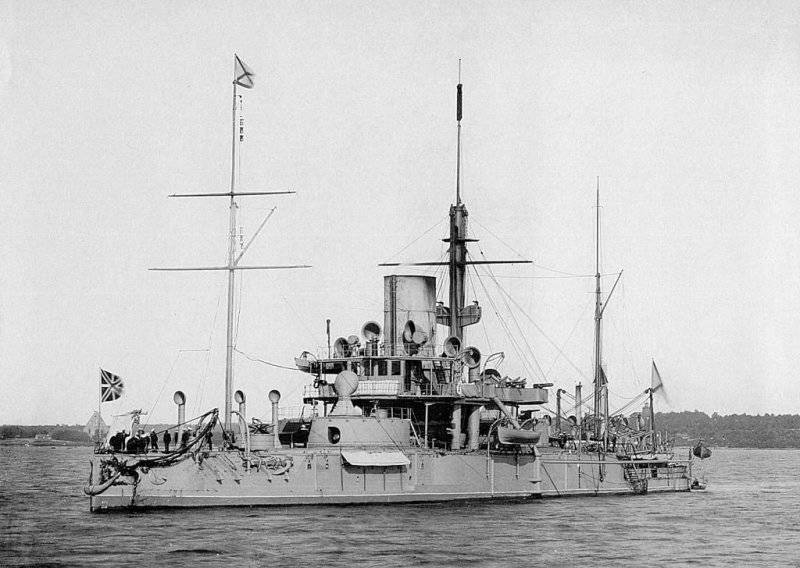
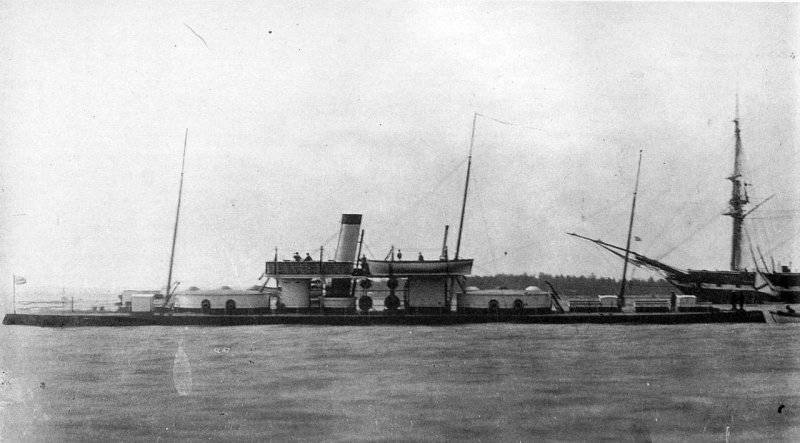
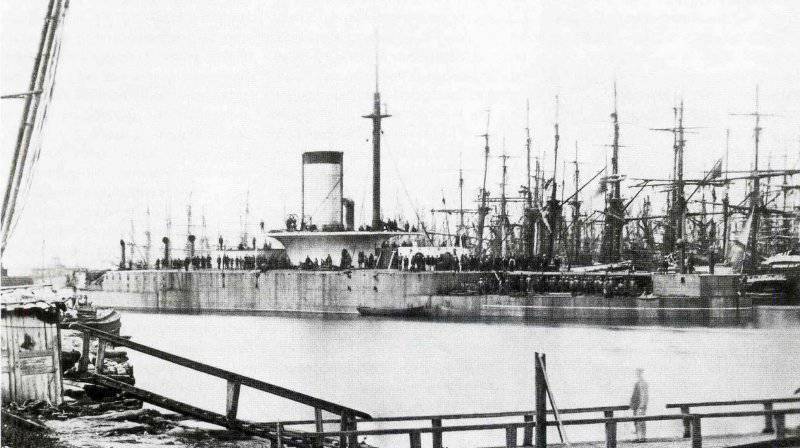
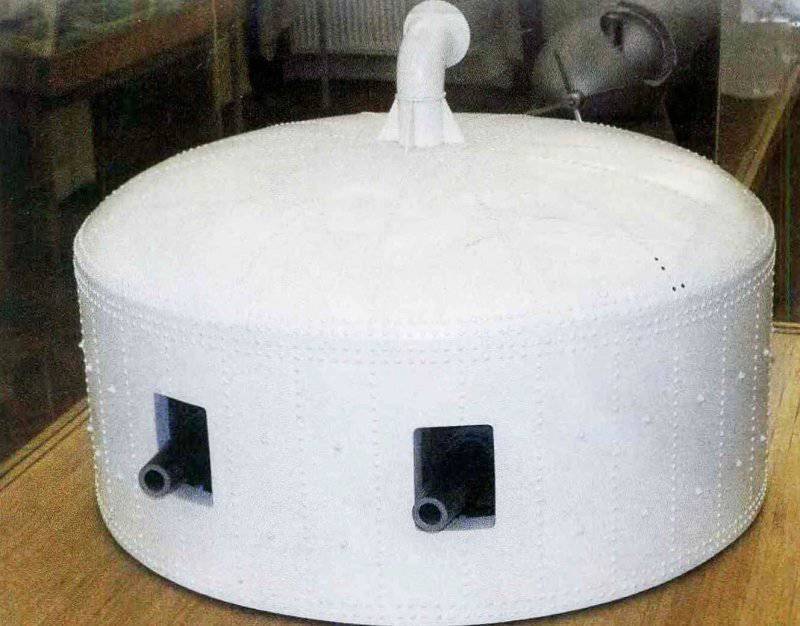
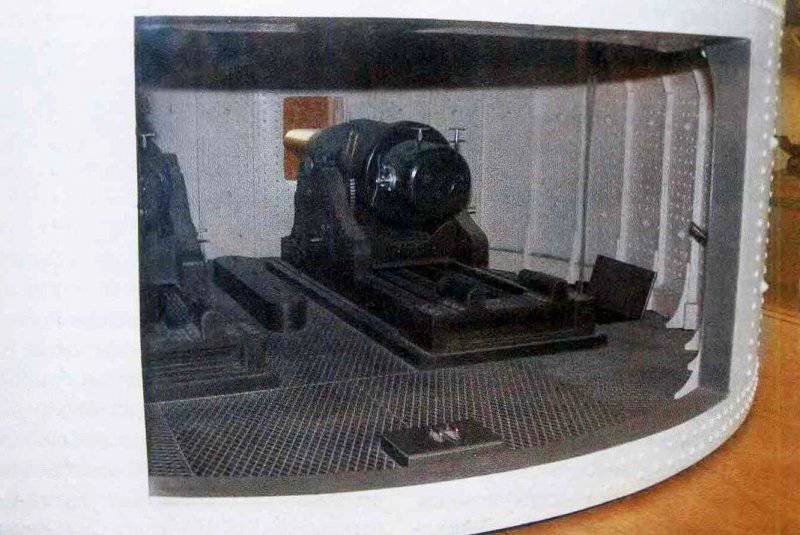
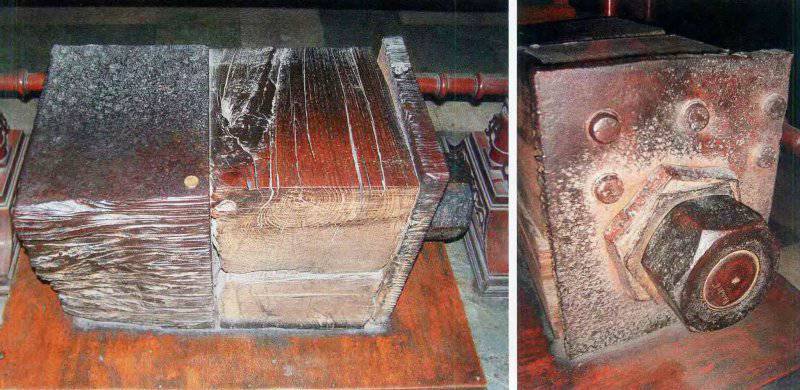
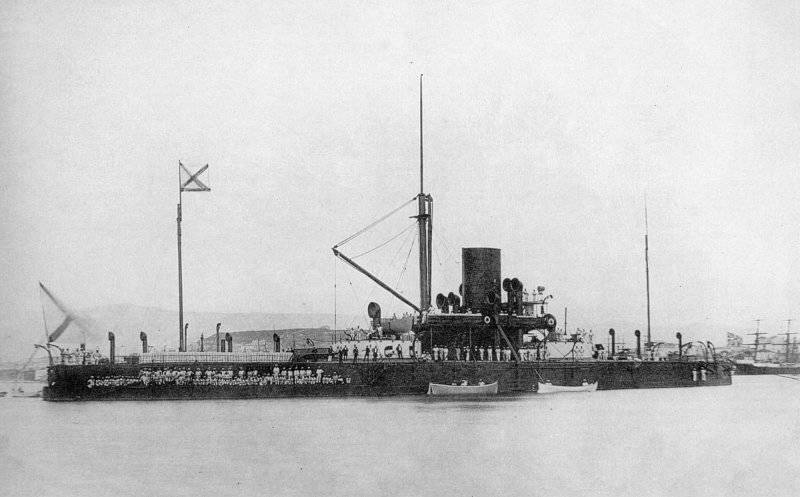
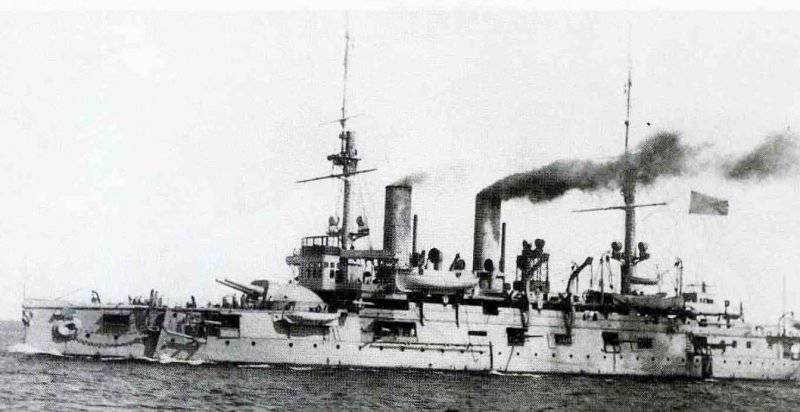
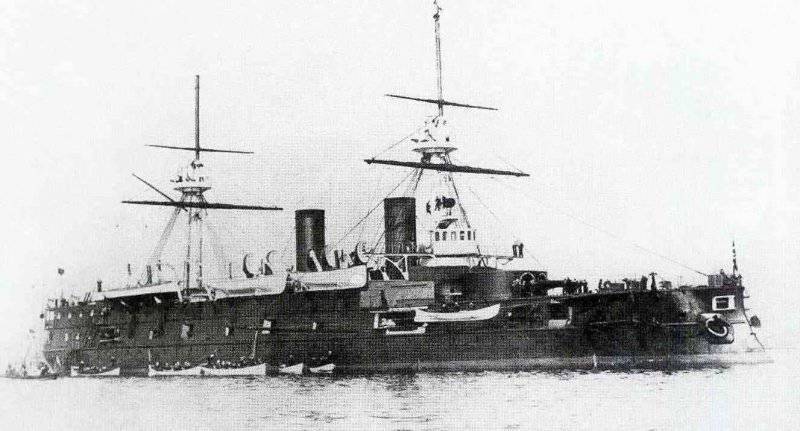
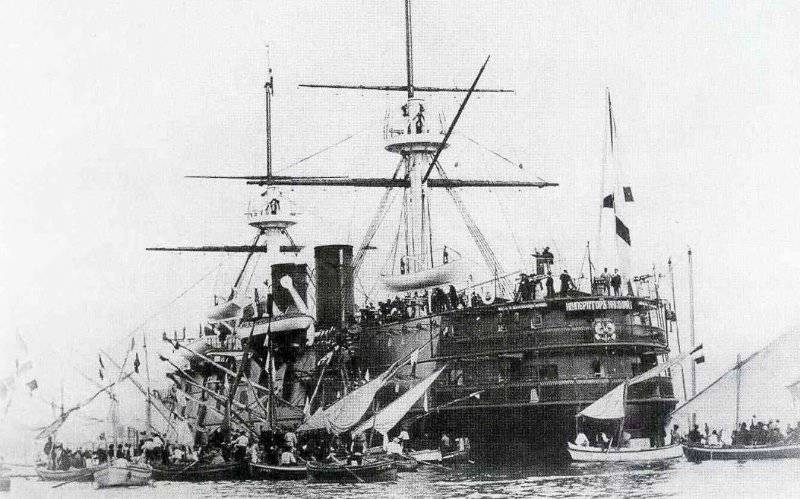
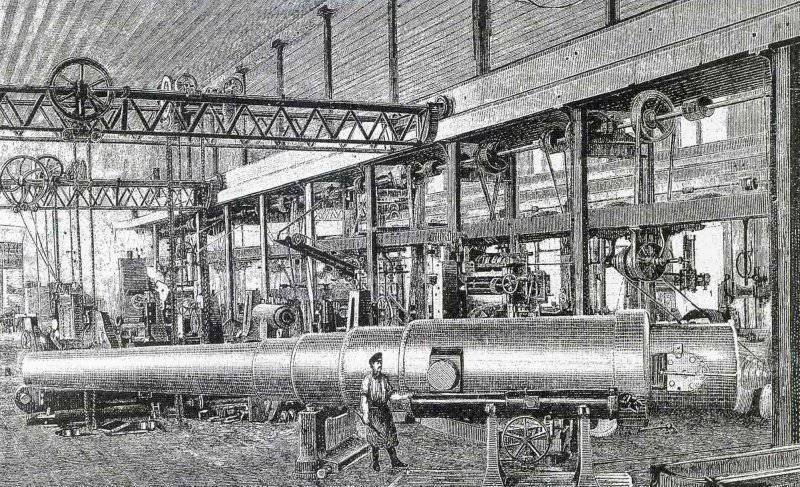
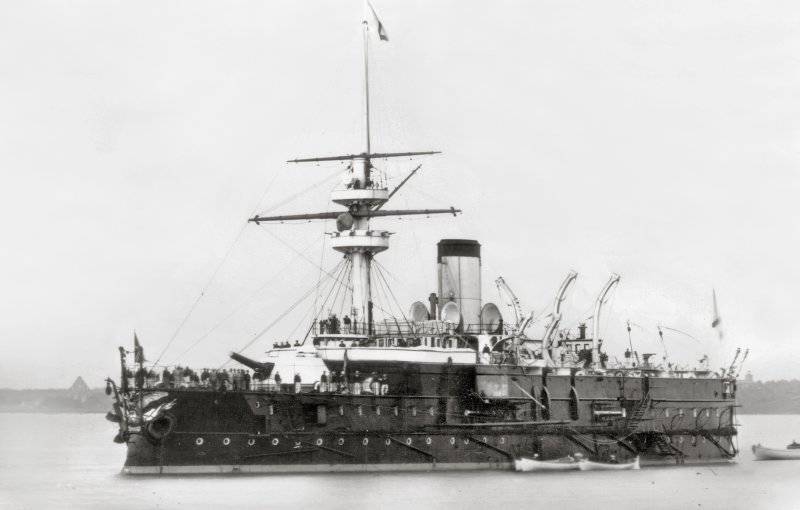
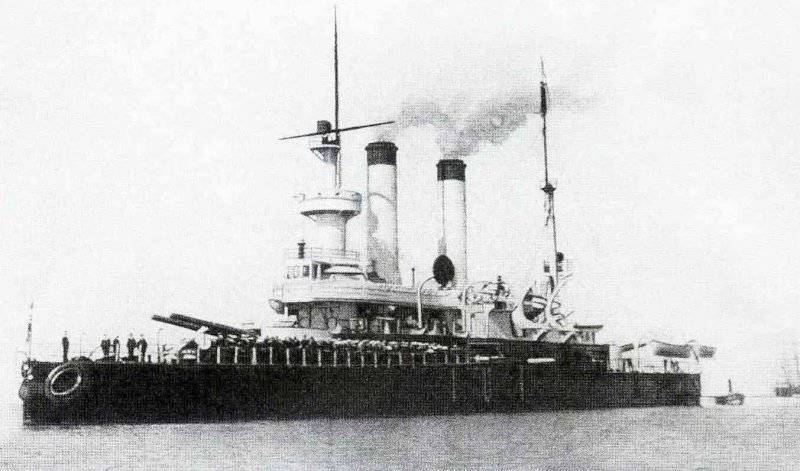
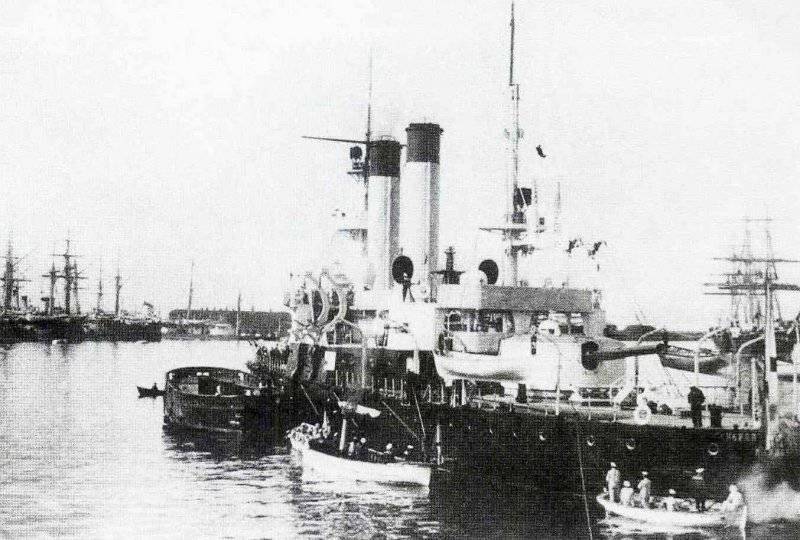
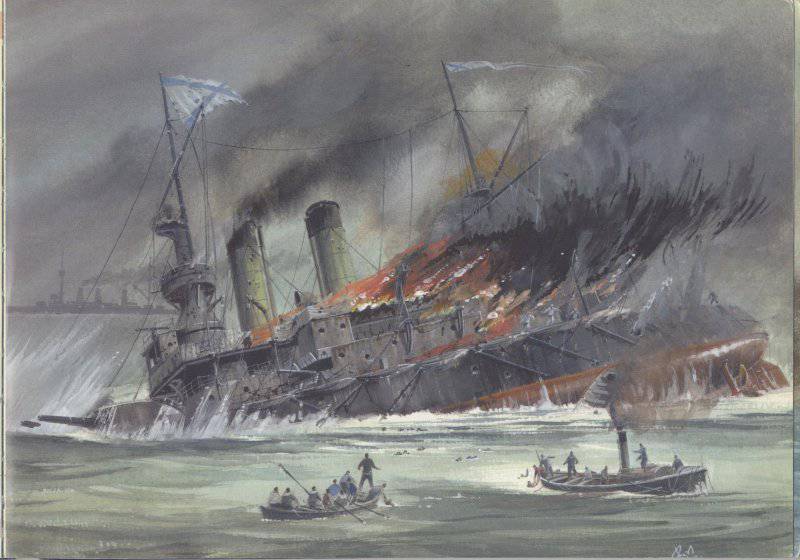
Information